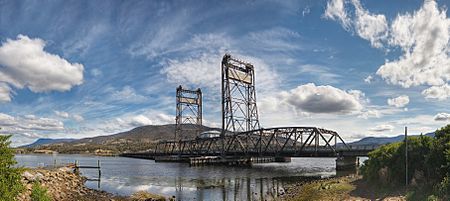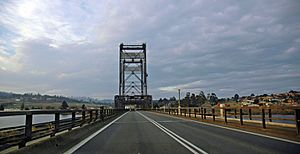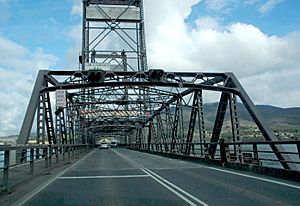Bridgewater Bridge (Tasmania) facts for kids
Quick facts for kids Bridgewater Bridge |
|
|---|---|

The Bridgewater Bridge
|
|
| Coordinates | 42°44′27″S 147°13′31″E / 42.74083°S 147.22528°E |
| Carries | Midland Highway South Railway Line |
| Crosses | Derwent River |
| Locale | Hobart, Tasmania, Australia |
| Named for | Bridgewater |
| Owner | Department of State Growth |
| Characteristics | |
| Design | Truss bridge with vertical lift |
| Material | Steel |
| Piers in water | 13 |
| History | |
| Construction begin | 1939 |
| Opened | 1946 |
| Replaces | Swing punt (c. 1900s-1946) |
The Bridgewater Bridge is a special bridge in Hobart, Tasmania, Australia. It carries both a road, the Midland Highway, and a railway line, the South Railway Line. This bridge crosses the Derwent River.
It's a steel truss bridge with a vertical lift section. This means a part of the bridge can be lifted up to let boats pass underneath. The bridge and a long causeway connect the suburbs of Bridgewater and Granton. It was finished in 1946. It has two lanes for cars, one railway track, and a separate path for people to walk on.
This bridge is very important because it connects the Midland Highway on the eastern side with the Brooker Highway on the western side. It's also the oldest lift-span bridge still working in Australia. When the bridge lifts, it can cause traffic to stop for a while.
Contents
History of the Bridgewater Bridge
The Bridgewater Bridge was one of the first bridges built in Tasmania. This happened after British settlers arrived in 1803. The bridge even gave its name to the nearby town of Bridgewater.
Lieutenant-Governor George Arthur ordered the bridge and causeway to be built. It was part of a main road connecting Launceston and Hobart. This road helped people reach farms in the middle of Tasmania more easily.
Building the Causeway
Work on the bridge started in 1829. Roderic O'Connor was in charge of the project. The causeway was built first. About 200 convicts, who were prisoners sent to Tasmania, did the hard work.
They used only shovels, picks, and wheelbarrows. They moved about 2 million tonnes of soil, stones, and clay. The finished causeway was about 1.3 kilometers long. It didn't go all the way across the Derwent River. The first plan was for a viaduct (a bridge with many arches), but this idea was changed. The half-built arches were filled in to make the causeway we see today.
The First Bridges Over the River
After the causeway was built, a punt (a flat-bottomed boat) carried people and goods across the deep part of the river. But it couldn't handle all the traffic. So, the first bridge opened in 1849. It was designed by James Blackburn.
This first bridge was a swing bridge. This meant it could swing open to let ships pass. In the late 1870s, the Tasmanian Main Line Railway wanted to lay train tracks over the causeway. So, the causeway was made wider, and the swing bridge was changed too.
In 1886, a train accident happened on the bridge. The engine went off the tracks and nearly fell into the water. Sadly, two people died. The accident happened because the train tracks didn't line up correctly when the bridge was closed. The bridge was fixed again after this. This bridge was used for many decades. It was replaced by another swing bridge in the early 1900s. You can still see parts of the old swing bridge next to the current one.
The first two swing bridges didn't go straight from the causeway. They turned a little to the right. The second swing bridge stayed open while the new lifting bridge was being built. This was to keep traffic moving. That's why the current bridge looks like it turns a bit from the causeway.
The Current Lift Bridge
Work on the current steel vertical lift bridge started in 1939. Building was paused because of World War II. The bridge opened for road traffic in March 1942. The lifting part was finished in early 1946. Trains started using it in late 1946.
The bridge has a long concrete section leading from the causeway. Then there's the steel lifting part, just before the northern side of the river. This lifting section is one of only a few left in the Southern Hemisphere. It's the biggest of its kind still in Australia. The bridge was built to last for 100 years.
There's a small control house on the lifting section. Inside are the controls that raise and lower the bridge. Until 1984, a paper mill at Boyer used to send all its paper by river. Barges carried the paper to storage sheds in Hobart. This meant the bridge had to open very often.
Because of this, a person called a bridge-keeper lived nearby. They would open and close the bridge when needed. But when the mill stopped using the river for transport, a full-time keeper wasn't needed anymore. The bridge can still open, but it doesn't happen very often now.
Around 2003 to 2005, cameras were put on the lifting part of the bridge. This was to stop people from damaging the control house.
In 2006, a problem was found with one of the steel cables. These cables hold up two heavy concrete counterweights, which help lift the bridge. The bridge had to close for a short time. This caused big traffic jams, as cars had to use other bridges like the Bowen and Tasman bridges. The cables were put in place in 1994 and were supposed to last 20 years. But they only lasted about half that time. Trains stopped using the bridge in 2014.
Engineering History
The Bridgewater Bridge is recognized as an important piece of engineering history. It received a special marker from Engineers Australia.
Plans for a New Bridge
Between 2001 and 2005, the Australian Government set aside $100 million to replace the Bridgewater Bridge. The Tasmanian Government decided to build the new bridge south of the old one. However, there were some delays and issues with the old bridge's historical importance. The new bridge is part of a bigger plan to improve the Brighton Bypass and Midland Highway.
Around 2010, the Tasmanian Government showed plans for a new bridge next to the current one. The new bridge will carry the Midland Highway. The old Bridgewater Bridge will stay open for trains, walkers, and local traffic. Even though the old bridge struggles with modern traffic, it's a very important landmark with a lot of history.
From 2006 to 2010, the lifting part of the Bridgewater Bridge wasn't working well. The government spent $14 million to fix it up. This was supposed to make it last another 15 years until a new bridge could be built. The repairs included fixing the control house and all the cables. It was hoped the bridge would open regularly for tourist boats. However, it has only opened a few times successfully and has caused big traffic delays. One time, it only lifted a tiny bit and got stuck!
In 2016, a study looked at different ideas for a new bridge. In 2018, the Australian Government announced a grant of $461 million for a new Bridgewater Bridge. This covers 80% of the cost. The Tasmanian Government will pay the remaining $115 million.
Construction was planned to start in 2019. However, more studies found some issues that might add to the costs. So, the design and approval process is happening now. Building is expected to start in 2022 and finish in 2024. The new bridge will be about 1.6 kilometers long. It will be a concrete box girder bridge with two separate roadways. It will have a clearance of 16.2 meters above the Derwent River, meaning boats can pass underneath without it needing to lift.



